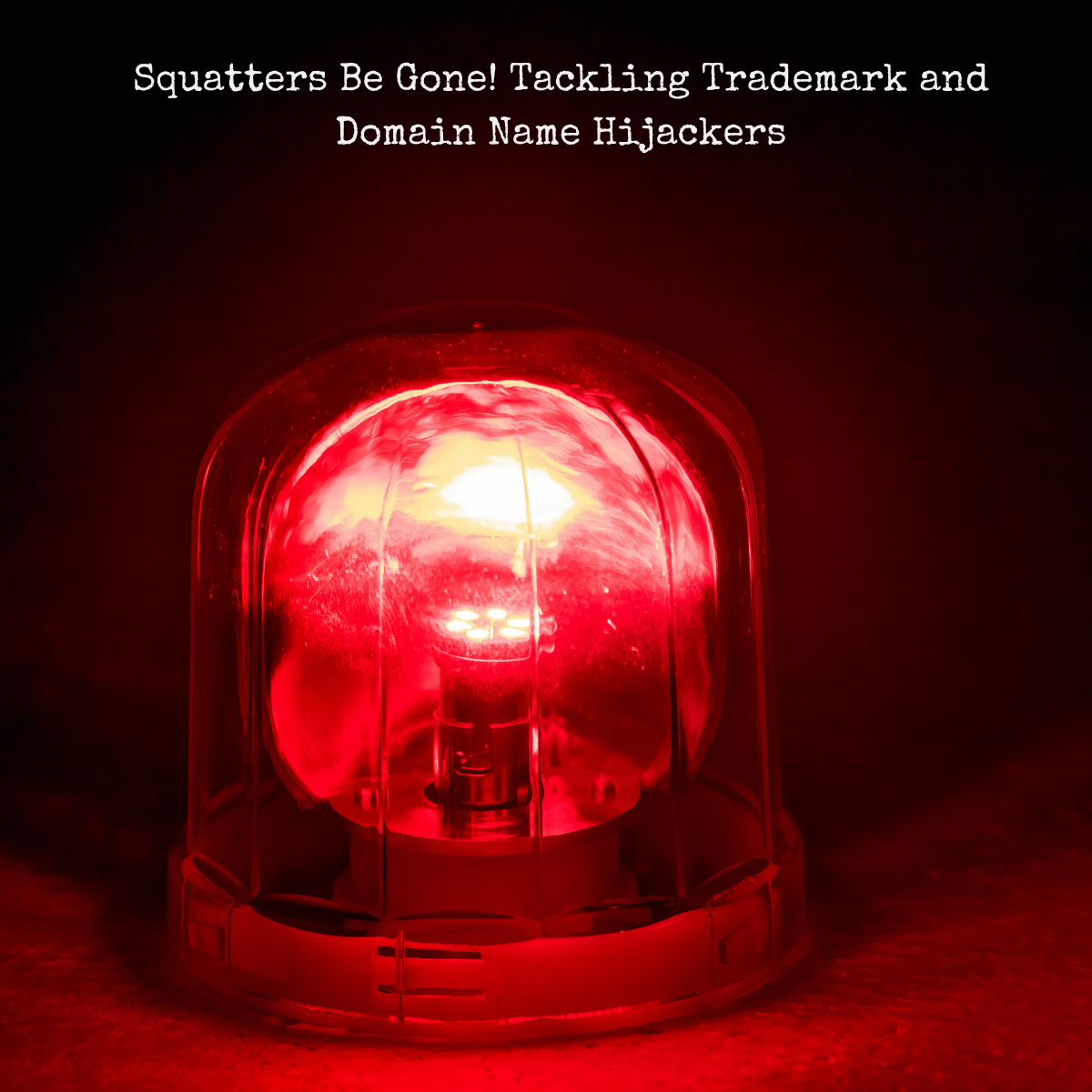Squatters Be Gone! Tackling Trademark and Domain Name Hijackers
Adrian Thomas
12 Aug 2025
•5 min read

With the growth of online commerce and globalized brands, trademark squatting and domain name disputes have become prevalent issues for businesses. Companies invest significant resources in building their brands, only to find their trademarks or similar names being registered by third parties without authorization. This practice, often referred to as “trademark squatting” or “cybersquatting” when it involves domain names, can create barriers to market entry, increase business costs, and even harm brand reputation.
In this blog, I’ll explain the ins and outs of trademark squatting and domain name disputes, outline your legal options for recovering trademarked assets, and highlight recent case law to illustrate practical approaches.
What Is Trademark Squatting?
Trademark squatting occurs when an individual or entity registers a trademark that is already in use by someone else, often in a country where the original owner hasn’t registered it yet. In many jurisdictions, including the United States, trademark rights are typically granted to the first party to use the mark in commerce. However, in certain countries—like China—the first to register the mark often has the advantage, regardless of prior use by others elsewhere.
Example: Apple in China
One famous case of trademark squatting involved Apple’s “iPhone” brand in China. A Chinese company, Xintong Tiandi, had registered the “IPHONE” trademark for leather goods before Apple entered the Chinese market. Apple subsequently found itself entangled in a legal battle to reclaim its brand. The Chinese courts ultimately ruled in favor of Xintong Tiandi, showing how complex and costly trademark squatting can be, especially in first-to-file jurisdictions.
Understanding Domain Name Cybersquatting
Cybersquatting involves registering, selling, or using a domain name with the intent to profit from someone else’s trademark. Cybersquatters often target recognizable brands, anticipating that the brand owner will be willing to purchase the domain for a premium to prevent consumer confusion or brand dilution. Fortunately, the Anticybersquatting Consumer Protection Act (ACPA) and the Uniform Domain-Name Dispute-Resolution Policy (UDRP) offer legal recourse for brand owners affected by cybersquatting.
Example: Madonna v. Dan Parisi
In Madonna v. Dan Parisi, the pop singer Madonna filed a UDRP complaint to reclaim the domain name “madonna.com.” The arbitrator ruled in her favor, concluding that the domain name was registered in bad faith and primarily for the purpose of selling it to her at a profit. This case demonstrated that even globally recognized figures face challenges in cybersquatting but have pathways to recovery through UDRP.
Key Legal Avenues for Addressing Trademark Squatting
Legal Actions in Relevant Jurisdictions
In certain countries, you may be able to contest a trademark squatter by proving that you held rights to the trademark first or that the registration was made in bad faith. For instance, in countries where trademark squatting is rampant, such as China and Brazil, demonstrating prior use or the international reputation of your brand can sometimes help you reclaim your mark.
Trademark Opposition and Cancellation Proceedings
Filing an opposition or cancellation petition may be an option in some jurisdictions if you can demonstrate that the squatter’s registration was done in bad faith. In China, for example, Apple tried this approach in its case against Xintong Tiandi. While not always successful, these proceedings can prevent squatters from using or transferring your brand to competitors.
Madrid Protocol and Trademark Monitoring
Registering your trademark internationally through the Madrid Protocol can prevent squatting by establishing your rights in multiple jurisdictions with a single application. Additionally, consistent trademark monitoring and policing are crucial for identifying potential squatters early and taking preventative action.
Addressing Domain Name Cybersquatting: ACPA and UDRP
When it comes to cybersquatting, U.S.-based businesses have two main options:
Anticybersquatting Consumer Protection Act (ACPA)
The ACPA allows brand owners to file lawsuits in federal court against domain registrants who are using a domain in bad faith. To succeed under the ACPA, the plaintiff must demonstrate that:
- The domain name is identical or confusingly similar to a distinctive or famous trademark.
- The domain was registered or used in bad faith.
In Coca-Cola v. Purdy, for example, the defendant registered multiple domains related to Coca-Cola products. Coca-Cola filed an ACPA complaint and won, resulting in the court ordering the transfer of the domains to Coca-Cola. This case illustrates how powerful the ACPA can be when dealing with cybersquatting on U.S.-based domains.
Uniform Domain-Name Dispute-Resolution Policy (UDRP)
The UDRP is an international arbitration process available to trademark holders seeking to recover domains registered in bad faith. The complainant must show that:
- The domain name is identical or confusingly similar to the trademark.
- The registrant has no legitimate rights to the domain.
- The domain was registered and is being used in bad faith.
The UDRP process is generally faster and less expensive than traditional litigation, making it an attractive option for companies operating internationally. For instance, when Google discovered “g00gle.com” had been registered by a third party attempting to divert web traffic, it filed a UDRP complaint and won, successfully recovering the domain.
Practical Tips for Preventing and Managing Trademark Squatting and Cybersquatting
Register Your Trademarks Internationally
If you’re considering entering international markets, start by securing your trademark in those countries. The Madrid Protocol streamlines the international trademark registration process, making it easier for businesses to protect their marks in multiple countries with a single application.
Secure Multiple Domain Extensions
By registering common variations and extensions of your primary domain name (.com, .net, .org, etc.), you can minimize the chances of a cybersquatter gaining control of a domain that closely resembles your brand.
Engage in Active Trademark Monitoring
Regularly monitor trademark databases and domain registrations to detect potential infringements early. Trademark monitoring services can notify you of new applications for similar marks, enabling you to oppose them before they become registered.
Consider a Cease-and-Desist Letter First
Before resorting to costly litigation or UDRP proceedings, consider sending a cease-and-desist letter. In many cases, squatters will release the domain or trademark rather than face a legal battle, especially if they don’t have legitimate business plans for the mark or domain.
Work with Experienced Counsel for International Matters
Because different countries have unique trademark and domain laws, partnering with an experienced trademark attorney is crucial. They can guide you through the complexities of international trademark squatting issues and help you determine the most effective strategy for protecting your brand globally.
Recent Case Law Highlights
Booking.com and Generic Domain Names
The USPTO v. Booking.com B.V. case (2020) was pivotal for brand owners who use generic words in their domain names. The U.S. Supreme Court ruled that Booking.com could trademark its domain name, even though “booking” is a generic term. This landmark decision has implications for brand owners because it establishes that domain names, when distinctive in consumers’ minds, can still qualify for trademark protection.
Tesla’s Trademark Squatting Dispute in China
Tesla faced challenges when trying to register its name in China, as it was already registered by a local businessman. After unsuccessful negotiations, Tesla took legal action, ultimately settling with the registrant to reclaim rights. This case underscores how businesses can end up having to negotiate with squatters, particularly in first-to-file countries.
Twitter’s UDRP Win Over “twttr.com”
In a UDRP case, Twitter won rights to the domain “twttr.com,” which was registered by a third party seeking to redirect users to unrelated content. This case illustrates how brands can recover domains using UDRP when they’re clearly intended to divert or deceive users.
Conclusion
Trademark squatting and cybersquatting pose real challenges for businesses, especially as they expand into international markets. Understanding your legal rights and options is essential for protecting your brand assets. Whether through ACPA lawsuits, UDRP proceedings, or proactive trademark and domain management, there are effective strategies to help businesses protect their trademarks and reclaim their rightful assets.
At Hebert-Thomas Law, PLLC, we help brands navigate trademark squatting and domain name disputes. Contact us if you need guidance on protecting your brand from squatters or if you’re facing a domain dispute. We’re here to help you secure your brand’s identity, wherever it may be challenged.
Subscribe to newsletter
Subscribe to receive the latest blog posts to your inbox every week.
By subscribing you agree to with our Privacy Policy.



